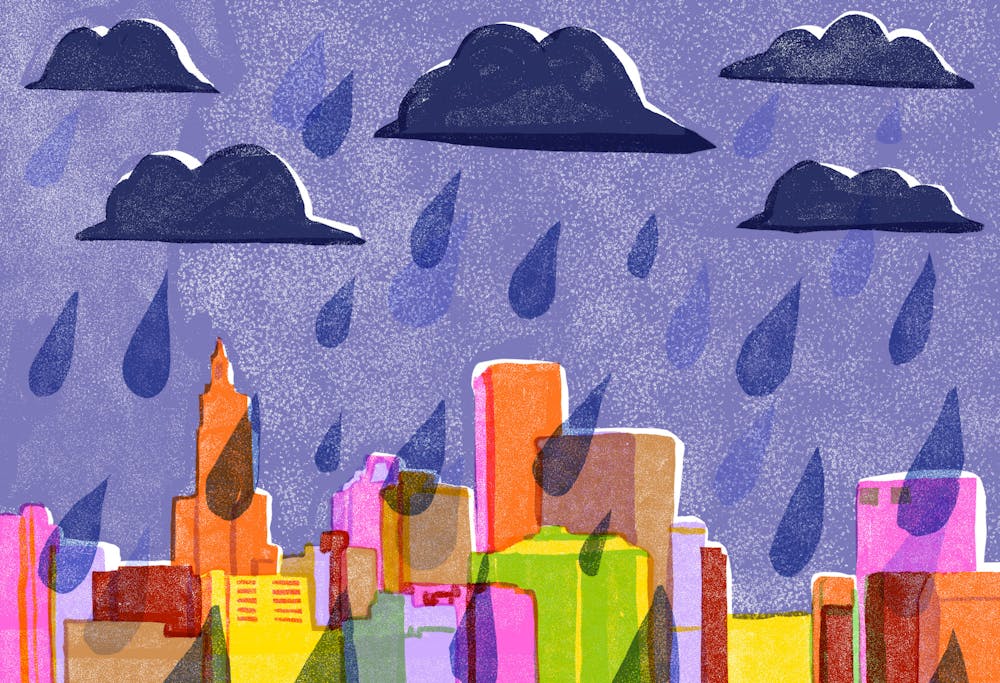The National Oceanic and Atmospheric Administration released its State Climate Summaries for 2022 last month. The Rhode Island report — written by climate researchers Jennifer Runkle and Kenneth Kunkel — predicts unprecedented warming, extreme precipitation events and sea level rise that could cause coastal flooding and erosion in the Ocean State by the end of the century.
But Rhode Island officials say they are working to adapt in the face of the impacts of climate change.
According to the report, the state recorded its highest number of days above 90 degrees over the past several years, while the number of cold nights appears to be trending downward.
The planet “is warming, it has been warming. The last two decades have been the warmest in the history of climate records,” Kunkel said. He also highlighted the impact of sea level rise for a coastal state like Rhode Island — namely, more frequent and intense floods.
Created to supplement the National Climate Assessment, which had its latest iteration published in 2018, State Summaries provide a more efficient source for state officials to develop and coordinate policies, according to Kunkel.
“The idea is to provide easily (digestible) information for the state,” he said. Kunkel added that the reports are aimed not at the scientific community but instead at local governments, the private sector and the general public. “We are trying to convey information to a very wide spectrum of our citizenry, so (the reports) are written to be fairly accessible.”
Professor of Earth, Environmental and Planetary Sciences Baylor Fox-Kemper also explained the role of State Summaries in policy formation. “Focusing on Rhode Island alone has a potential political importance to the state government that other climate reports would not have,” he said.
The report can also help identify Rhode Island’s best options for tackling the immediate consequences of climate change, Fox-Kemper added. “Rhode Island is not a major emitter worldwide, but we can do our part and have a stronger negotiating position with other states in New England and … the federal government to put stronger reductions into place.”
For Fox-Kemper, the report is also an “awakening to the people of Rhode Island that we are in for a very substantial sea level rise by the end of the century.” He added that, since Rhode Island cannot stop global emissions on its own, it is crucial that the state undertakes climate adaptation efforts as well as mitigation measures.
“These changes are probably going to come whether Rhode Island does this or not, so we can save lives by thinking of ways to adapt using this information at hand,” he said.
The report notes that, due to local conditions, the Northeast will see more sea level rise than the global average. In a low-emission scenario, global sea level is projected to rise one foot by 2100. In the most extreme conditions, the increase could be as high as eight feet.
“We have only seen about nine inches so far, but we are already seeing consequences for salt marshes and low-lying places around Rhode Island," Fox-Kemper said.
If sea levels increase by four feet, which is the intermediate emissions projection, areas without flood protections — such as Barrington, Central Falls, Harwick, the Port of Providence and more — will suffer from massive changes, he explained. “Places will have to be abandoned and infrastructure for the state will have to be rebuilt.”
In response, the state government has created tools to mitigate the impact of sea level rise.
In an email to The Herald, Laura Dwyer, public educator and information coordinator for the Rhode Island Coastal Resources Management Council, highlighted initiatives such as STORMTOOLS, the Coastal Hazard Application and the Shoreline Change Special Area Management Plan, also called Beach SAMP.
These resources can help users assess, understand and educate themselves about the potential risks of inundation with water at specific addresses.
Beach SAMP specifically “aims to improve the coastal resiliency of cities and towns throughout Rhode Island to the threats of erosion and flooding caused by storm events or sea level rise,” according to its website. SAMP was developed “using up-to-date research and expertise from a wide range of public and private sectors.”
In addition, Governor Dan McKee has taken steps to fund the security of areas at high risk from climate change. Beyond the $150 million investment in climate change policy proposed in his fiscal year 2023 budget — which includes a series of measures that can mitigate the impacts of sea level rise — he proposed a green bond on the ballot in November, according to Michael Healey, chief public affairs officer for the Rhode Island Department of Environmental Management.
“That green bond includes, among other things, $16 million for the Municipal Resilience Program administered and financed by the Rhode Island Infrastructure Bank,” Healey wrote in an email to The Herald. “This matching grant funding stream helps local communities restore and improve resilience of vulnerable coastal habitats, river and stream floodplains and infrastructure.”
Fox-Kemper also emphasized the importance of continuing to prioritize and expand policies to aid vulnerable communities navigating the impacts of climate change in Rhode Island.
“There are many studies that show that affluent communities have an easier time adapting,” he said. “It is the communities in Rhode Island that do not have those resources that we should be most concerned about.”
This prioritization means building up the state’s climate resilience on every front, from investing in infrastructure and restoring wetlands to addressing the social structure itself, “making sure our insurance policies are affordable and accessible,” Fox-Kemper said.
Despite the need for immediate local action, Kunkel said that one state alone cannot solve climate change. “Everything goes into the common atmosphere and you are stuck with the decision of all your global neighbors,” he said.
While every action helps build a more sustainable future, Kunkel noted, “it is going to take decades to get to a point in which we are not increasing greenhouse concentrations in the air, even under the best circumstances. So, one has to prepare for certain changes, and that means strong actions to adapt.”

Julia Vaz was the managing editor of newsroom and vice president on The Herald's 134th Editorial Board. Previously, she covered environment and crime & justice as a Metro editor. A concentrator in political science and modern culture and media, she loves watching Twilight (as a comedy) and casually dropping the fact she is from Brazil.





